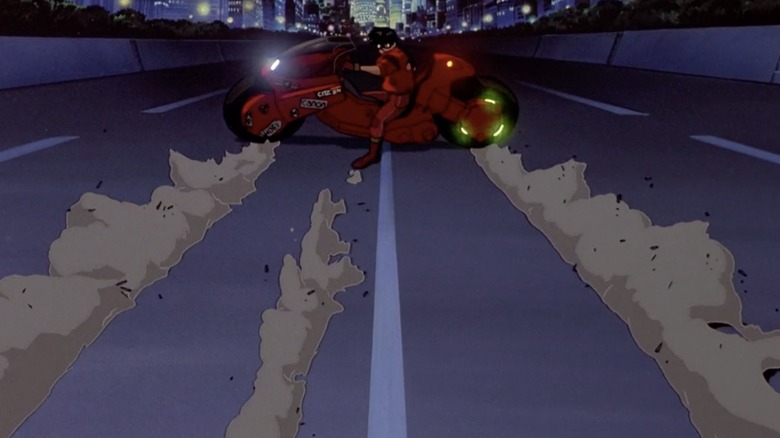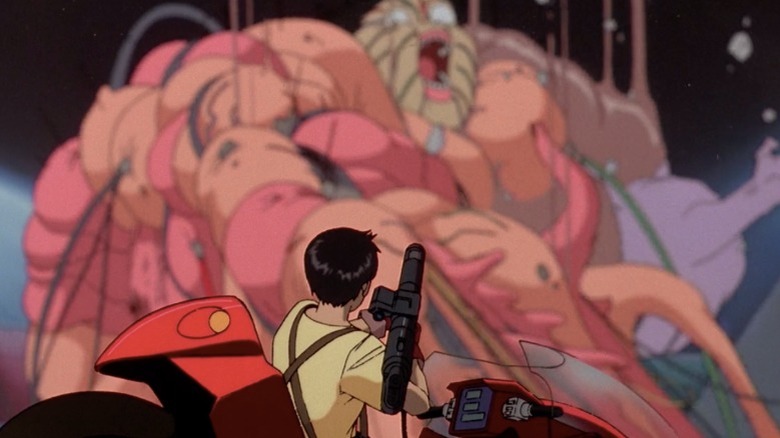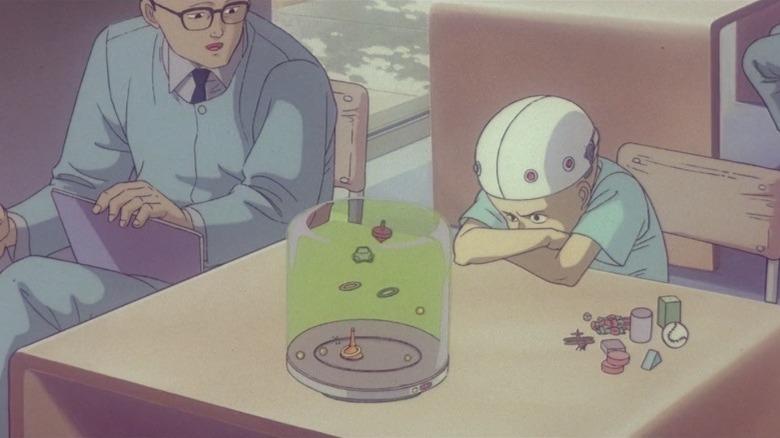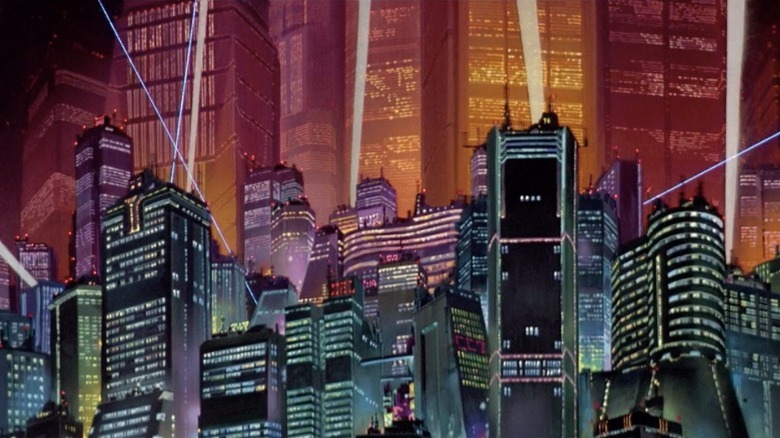Akira Ending Explained: The Search For Power Always Leads To Destruction
The sheer scope of director Katsuhiro Otomo's masterpiece anime "Akira" is mind-boggling. While the film only takes place over several days, the spiritual and philosophical density of its myth extends far beyond that timeframe, into both the past and future. The movie begins with an apocalyptic explosion, unsubtly reminiscent of Hiroshima, which has for decades continued to be a point for reference for Japanese science-fiction. The origin of that explosion is the namesake Akira, a psychic child (also called an ESPer) who ascended to the level of a God and whose power kickstarted a singularity that destroyed the world and created a new one. Akira exists in the film as both a metaphysical entity — a stand-in for various deities — but also exists in a physical form, deep beneath the surface of Neo-Tokyo. Neo-Tokyo is the setting of "Akira," and it's a post-apocalyptic hellscape of flashing lights, conspiracy cultists, military raids, and biker gangs. Navigating their way through this tumultuous city are two best friends Kaneda and Tetsuo.
Kaneda and Tetsuo's divergent paths in the film are foreshadowed early on during the biker war between two gangs known as the Clowns and Capsules. Kaneda and Tetsuo are both members of the Capsules, but Kaneda is the leader. He chides Tetsuo's bike inexperience before the battle, saying "my bike is too wild, you wouldn't be able to handle it." Tetsuo goes out to prove himself with his own bike, but inadvertently crashes into a child named Takashi on the highway. Takashi, one of three known ESPers in the government's custody (the other two are Kyoko and Masaru), passes on some of his powers to Tetsuo. Tetsuo starts to have horrific audial and visual hallucinations of Akira, and they begin to consume him.
A Power to Great for Us to Understand
In the end of the film, when Tetsuo comes into the presence of Akira's true power, he transforms into a horrific amorphous giant of flesh, cells, and organs, marking that his human form is being usurped by the galactic force of Akira. He yells "My body isn't doing what I tell it to, it's acting on its own!" The three ESPer children are awed by the presence of Akira and begin praying to him, understanding that the birthing of a new world is inevitable and that Tetsuo will ultimately be released from his mortal form. They end up helping Kaneda and Tetsuo's girlfriend Kairo, who came to rescue Tetsuo, return to safety but most of Neo-Tokyo is yet again destroyed in a mass explosion.
Tetsuo's ultimate and perhaps pre-ordained conjoining with Akira comes from his desire to be thought of as powerful and important. Throughout the movie, Tetsuo is considered a side-kick or novice to Kaneda and the combination of his inferiority complex with his newly attained powers proves to be lethal. At first Tetsuo is terrified of his abilities, but he begins to harness them and his ego takes over. Tetsuo asks Kaneda in their final confrontation inside of the stadium "Why do you always have to save me? Yeah, I admit I've gotten beaten before, but I won't always be on the receiving end you hear?" This search and ultimate attainment of power is not only about proving his own self-worth, but of revenge against those who doubted him.
Fending For Ourselves
The human desire of control and retaliation that leads to the calamitous ending is present in many characters throughout the film, which Otomo fleshes out as a political allegory of end-times. We see military intervention and a General Patton-like brute confidence by Colonel Shikishima. He orders a coup d'etat and a forceful military attack to stop Tetsuo's powerful ascent at all costs. He exudes an arrogant anthropocentric outlook that comes into conflict with the supernatural and galactic forces he is reckoning with. On the opposite side of the spectrum are cultists who worship the coming of Akira like a Biblical rapture and openly embrace in the destruction of this world and the creation of the next. But even they are naïvely anthropocentric, believing narcissistically that Akira's resurrection is for the benefit of humanity. The cult is also led by a single man who is carried on a giant throne across the city. It's one of several ways Otomo critiques the hypocrisy of individual self-importance even in the face of collective catastrophe.
A Chance to Break the Cycle
The animation in Akira toes the line between the beautiful and bleak. The frames are filled with dark orange, black, and red hues that paint Neo-Tokyo are menacing and perfectly characterize a city that seems to exist in perpetual violence. The people who populate the city are nearly always angry, worried, and suspicious. It embodies the feelings of a fractured society that leaves everyone feeling alone. This emptiness is exemplified in the climactic impact of the ending — a series of flashing panels, a massive explosion, and the pitch black of space — is both spectacular and deadening. Its finality leaves a crater in its wake.
Yet, in the final moments where Tetsuo and Kaneda are together, engulfed by a blinding light and force of Akira, they see flashbacks to different points in their friendship. The sequences highlight the ways in which Tetsuo's superhuman mental abilities were there from the start, but his shy nature and weak physicality relegated him to have to be protected under the wing of the bolder Kaneda. In all the film's tragedy, these nostalgic moments in the face of Akira suggest a chance to learn in what is left behind. After the explosions, after the destruction, rays of light shine down on the rubble of Neo-Tokyo, a mixed signal in the wake of despair. The question in the end becomes, can people learn to not repeat the cycle? After Akira, Tetsuo's insatiable need for power led to another cataclysmic event, but this time, as Kaneda and the rest of humanity picks up the pieces, perhaps they can make sure it's the last time.



